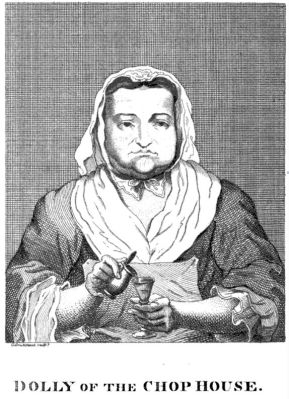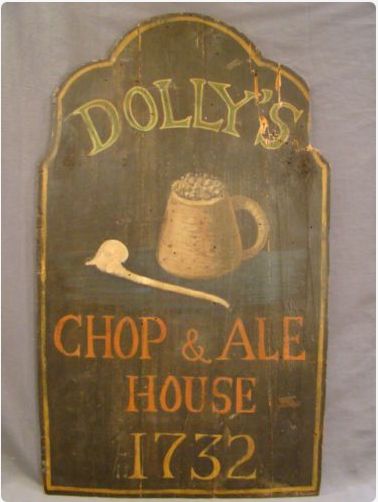Tags
Street View: 5
Address: Queen’s Head Passage
You might be forgiven in thinking that the address for Dolly’s Beef Steak House was 42 Newgate Street when looking at the elevation at the top of this post, but that is not true. The Steak House could be reached through the passageway under number 42 Newgate Street and is just as often referred to as ‘off Paternoster Row’, that is, the other side of Queen’s Head Passage. Queen’s Head Passage was also sometimes referred to as Queen’s Head Court. Horwood’s 1799 map below shows the passage between the two streets; Paternoster Row on the bottom and Newgate Street at the top. And below the map a drawing by T.H. Shepherd of 1856, showing the entrance to the establishment itself.
Although Tallis refers to Dolly’s as a Beef Steak House, Shepherd writes Steak & Chop House on the panel at the entrance to the establishment and Dolly’s Hotel on the lamp. Other sources do indeed show a huge variety in the way they refer to Dolly’s, but there was apparently only one “Dolly’s” and everybody knew what the various references meant. It had allegedly all started in the early eighteenth century when Queen Anne gave the premises to her favourite cook Dorothy, or Dolly, who was astute enough to make sure that her waitresses and bar maids were well turned out, thereby softening the blow for the customers when the bill came. One gentleman was so taken by the lovely waitress that a poem was written about them and immortalised in an engraving.
Embed from Getty Images
 The attractiveness of the waitresses was in stark contrast to the appearance of Dolly herself as the few portraits that exist of her are anything to go by, although I am not sure any were made in her lifetime and they could be flights of later imagination. This one is taken from volume 3 of James Caulfield’s Portraits, Memoirs, and Characters of Remarkable Persons, from the Revolution in 1688 to the End of the Reign of George II (1820) and made a century after the original Dolly had her chop house.
The attractiveness of the waitresses was in stark contrast to the appearance of Dolly herself as the few portraits that exist of her are anything to go by, although I am not sure any were made in her lifetime and they could be flights of later imagination. This one is taken from volume 3 of James Caulfield’s Portraits, Memoirs, and Characters of Remarkable Persons, from the Revolution in 1688 to the End of the Reign of George II (1820) and made a century after the original Dolly had her chop house.
Many now famous people partook of the steaks and chops on offer at Dolly’s; James Boswell went there on 15 December 1762 and wrote in his diary, “I resolved today to be a true-born old-Englishman” and to do that, he went to Dolly’s to partake of a solitary meal consisting of “a large, fat, beaf-steak to fullfill the charge of Beef-eating”. He thought beef-steak houses excellent places to dine as you could be warm and comfortable there, either joining in conversation, or not if the fancy so took you, and the price of the food was reasonable. “My dinner, beef, bread & beer & waiter was only a shilling”.(1) Boswell was to dine at Dolly’s more often, sometimes alone, sometimes with friends. Another, more frequent, customer of Dolly’s was George Fordyce, a physician, who dined there every day at four o’clock on the same menu, that is: chicken or fish for starters, then a rump steak of a pound and a half, accompanied by a tankard of ale, some brandy and a bottle of port. After all that he went home to receive his students for a lecture on chemistry. He was considered a poor lecturer; you wonder why, don’t you? You can read more about him and his drunken bedside manners here.
In 1786, Thomas Jefferson and a couple of friends came across a sign board advertising the chop house and decided to go inside. Apparently they enjoyed themselves so much there that they felt they had to write an apology to the person to whom they were supposed to go for dinner:
One among our many follies
Was calling in for steaks at Dolly’s
Whereby we’ve lost – and feel like Sinners
That we have miss’d much better dinners
…(2)

old sign board found on Pinterest
But fast forward to 1839 when Tallis produced his Street Views and Thomas Howell was the proprietor of Dolly’s Steak House. He had acquired the freedom of the City by redemption in 1837 and on the registration papers it is said that he was then 31 years old and the son of Robert Howell, a farmer of Oswestry, Shropshire. Howell’s address is already given as Dolly’s Chop House in Queen’s Head Court. A decade later, in 1846, a page-long article appeared in The Literary Garland, and British North American Magazine describing Dolly’s. It said that if you were coming from Newgate Street, “down a quiet court, silent as a cloister, and on the right hand side you will see Dolly’s Chop-House”. Combining this information with the one of Shepherd’s drawing, I think that Dolly’s was closer to Paternoster Row than to Newgate Street and that Shepherd showed the passage to Paternoster Row, rather than the one Tallis showed in Newgate Street. According to the anonymous author of the article, a more celebrated place could not be found and it had, in the century and a bit that it had existed, been visited by a large number of celebrated man (no women apparently), some of whom he described as partaking of the legendary steaks served at Dolly’s. For instance Dr. Johnson is imagined as coming there with Mr. Thrale to escape “the pleasant chattering of Mrs T”. Other famous guests he imagined sitting in the chop house were Oliver Goldsmith, Joshua Reynolds and Richard Brinsley Sheridan, but after all this name-dropping, he mentions Howell, the proprietor.
Howell keeps a very good cellar and keeps up the tradition of the house in serving excellent steaks, “firm, tender and juicy”. There is a separate smoking room which is referred to as Howell’s own City House of Commons. And best of all, according to the author of the article, the bill is surprisingly moderate and he resolved to “refresh our inward man for ever afterwards at Dolly’s Chop-house”.(3) But the “for ever afterwards” of the author in The Literary Garland was not for ever as the end for the chop-house came in 1881 when it closed its doors. The building was destroyed just over a year later to make way for a ‘Manchester warehouse’.(4) Despite the fact that the beef-steak-house has been demolished and this post has therefore come to an end, you can still see parts of the building as Elliot Stock, a publisher of Paternoster Row, had 10 copies of Oliver Goldsmith’s The Vicar of Wakefield bound with wooden boards taken from the panelling of Dolly’s Chop House. Number 4 (of 10) has been on the market and contains a paper label signed by Stock (see for a full description and a picture of the wooden boards here).
(1) James Boswell, London Journal 1762-1763, ed. G. Turnbull (Penguin Classics, 2014, p. 43-47). Waiters were given a penny as a tip.
(2) Kevin J. Hayes, The Road to Monticello: The Life and Mind of Thomas Jefferson (2008), pp. 313-314.
(3) The same article also appeared in The Aberdeen Journal, 22 January 1845.
(4) New York Times, 26 December 1881 and 8 April 1883.
Neighbours:
| <– 42 Newgate Street | 41 Newgate Street –> |






I once tried to find some trace of Dolly’s, but she left none. One of George IV’s courtiers, Sir William Knighton, sneaked off for a meal at Dolly’s while the King was at Epsom. The food must have been good.
Pingback: OMAD bij Dolly’s Chop-House | Maarten Hell
Pingback: The Big Houses Of The Heatons: Mersey Bank House – Part Two John Hall – allanprussell
Pingback: The History of Stockport in 100 Halls Part 98: Mersey Bank House – The History of Stockport in 100 Halls
Pingback: Regency Hot Spots: Dolly’s Beefsteak House – Regency Reader
My 4x great grandfather, Francis Lowndes was a surgeon and medical electrician who between 1802 and 1819 resided at 42 St Paul’s Churchyard. Would this be the same building that Dolly’s was in?